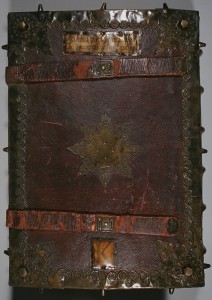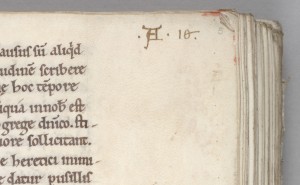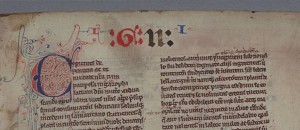Pressmark? Or what about shelfmark? They sound old-fashioned, bringing mental images of cupboards ("presses") and shelves where books are stored. "Call number" isn't just a modern term; it has geographical implications, too: the OED cites it as "orig. U.S." and it still seems more common in the United States, while in Great Britain these magical alphanumeric-possibly-cum-symbols labels may more frequently be termed "classmarks." But the term "call number" wobbles in the US, too: to some librarian colleagues who don't work in special collections, many of our materials don't have "call numbers" in that they aren't catalogued with Dewey Decimal or LC classifications. To us, a call number is worthy of that name when our readers use it to "call" for a certain book or folder; it's the way we find, and later replace the book or folder: the label doesn't need to incorporate subject information for its physical object to be requested, retrieved, reshelved.
And in the Middle Ages? Prof. Derolez (Catalogues de bibliothèques, 1979, p. 51) says that call numbers were rare in the 14th century, but quite common by the 15th, especially in the larger libraries that were neither of private nor of princely ownership. It's not hard to find images of various sorts of medieval call numbers, which sometimes include a term for the process of labeling them: signatus (does this imply that a “signum” was a call number?).
New York, Jewish Theological Seminary of America, Library, MS NH65, f. 148, detail. Ownership note and call number at the bottom of the last page with text, "Iste liber est monasterii sancte iustine de padua, signatus 459," with "signatus" meaning "signed" or "marked" where the call number is precisely and only that: a number. The book belonged to the Benedictine monastery of Sta. Giustina in Padua.
Then there's the kind of call number, equally sequential, but according to the alphabet; a good example is the "K" on the back cover of this very large choirbook. New York, Columbia University, RBML, Plimpton MS 041, back cover.
There are some medieval call numbers that are certainly tied to the text, for example those that begin with the first letter of the author's name, such as appear on these two manuscripts, both from Bury St. Edmunds in East Anglia. In this case the 14th century catalogue of the library survives, and there is no doubt that these books, both identifiable in the catalogue, are marked with the A for Augustine, embedded as they are within a series of other books, all containing works of Augustine, all with A call numbers.
Cambridge (MA), Harvard University, Houghton Library, MS Richardson 26, f. 1, detail. Upper outer corner of first text page, "A.6."
San Marino, Huntington Library, HM 31151, f. 1, detail. Upper outer corner of first text page, "A.10."
Sometimes this format of medieval call number –letter followed by a number– may be more arbitrary: the “G.ii” on this French manuscript marks a copy of Peter Lombard's Sentences; where’s the G in that? Maybe it was simply the seventh bookcase, and the second (or the eleventh) book in it.
New York, Columbia University, RBML, Plimpton MS 061, f. 1, detail. Center of upper margin of first text page.
But sometimes, even if the letter designates the bookcase, it still might almost be a classmark carrying some weight of intellectual content, and not solely a pressmark designating location. Consider the letter and number that signaled this book during the late 15th century: A.29. Not “A” for its author, but “A” because it inhabited the first bookcase, and it was in the first bookcase because it was the most important text: the Bible.
New York, Columbia University, Burke Library, UTS MS 072, front flyleaf, detail.
Ownership note and call number in the upper third of the otherwise blank front flyleaf, "Liber sancte marie de signiaco, signatus littera A, numero xxix," showing that the book belonged to the Cistercian house of Notre Dame de Signy, in the Ardennes, and that its call number was "signed" or "marked" with the letter and number combination, "A.29."
For descriptions and more images of the manuscripts mentioned here, please see the Digital Scriptorium.
Plimpton MS 041, the choirbook with the call number "K," is on loan to the Cleveland Museum of Art for the exhibition, The Caporali Missal: A Masterpiece of Renaissance Illumination, on view February 17 through July 7, 2013.





